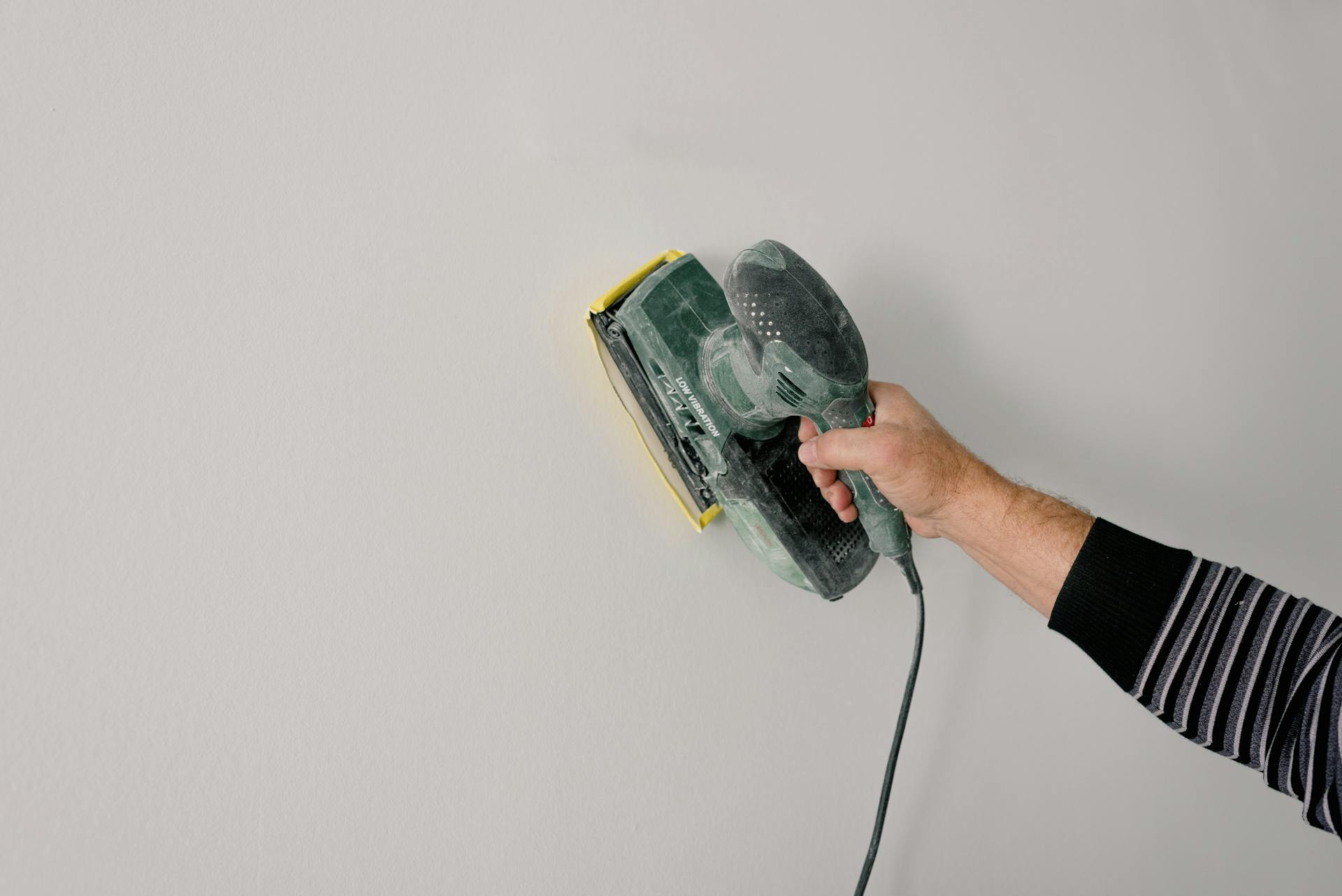
To get approved for a home equity line of credit (HELOC), you'll need to meet certain requirements. A credit score of 620 or higher is typically required, as lenders want to ensure you can repay the loan.
The amount of equity you have in your home plays a significant role in determining your eligibility for a HELOC. In general, lenders prefer to see at least 20% equity in the property. This means that if your home is worth $200,000, you'll need to have at least $40,000 in equity.
Lenders will also review your debt-to-income ratio to ensure you can afford the monthly payments. A debt-to-income ratio of 36% or lower is usually acceptable. This means that if you have a monthly gross income of $5,000, your total monthly debt payments should not exceed $1,800.
Suggestion: Does Heloc Affect Debt to Income Ratio
What is a Home Equity Line of Credit (HELOC)?
A Home Equity Line of Credit, or HELOC, is a type of loan that lets you borrow against the equity of your house. You can think of it as a credit card for your home.
HELOCs are different from traditional loans because you have a revolving line of credit, which means you can borrow and repay funds as needed. This flexibility is a big advantage of HELOCs.
Your house serves as collateral for a HELOC, and you can borrow up to a set limit. The interest rates on HELOCs are often variable, but they can switch to fixed rates later.
You only pay interest on the amount you withdraw from your HELOC, not the entire line of credit. This can save you money if you don't need to borrow the full amount.
HELOCs typically have a long borrowing term, such as 20 years, with an additional 15 years for repayments. This means your total term would be 35 years.
Consider reading: Maximum Heloc Amount
Basic Eligibility
To qualify for a home equity line of credit, you'll need to meet certain basic eligibility requirements. Your home's equity is a key factor, as lenders will consider the amount of equity you have in your home.
The combined loan-to-value ratio (CLTV) is another important factor. This is the total amount of loans against your home divided by its value. Most lenders will consider a CLTV of 80% or less.
Your credit score is also a crucial factor, with most lenders requiring a score of 620 or higher. However, some lenders may offer competitive rates to people with a score of 720 or higher.
A good debt-to-income ratio is also important, as lenders will consider how much of your income goes towards debt payments. A debt-to-income ratio of 43% or less is often considered acceptable.
Here's a breakdown of the basic eligibility requirements:
Your credit score is a three-digit number that estimates how likely you are to pay back the money you borrow. A higher credit score is better than a lower score.
Expand your knowledge: Heloc with 650 Credit Score
Importance of Good
Good credit is a must-have for a HELOC. You'll need a minimum credit score of 620 to qualify for a HELOC, and most lenders consider a score between 580 and 670 to be "fair".
Explore further: Heloc with 500 Credit Score
Your credit score is calculated based on several factors, including your payment history, which accounts for approximately 35% of your score. Making on-time payments is the quickest way to improve your credit score.
A good credit history signals responsible financial behavior, making timely payments. This can increase the chances of getting approved for competitive rates with lower monthly payments.
Your payment history is a significant factor in determining your creditworthiness. If you've been making timely payments on other credit products, such as personal loans or credit cards, that can work in your favor.
Here are the key elements that affect your credit score:
- Your payment history
- The number of accounts you have
- The length of your credit history
- The types of accounts you have
- The amount of credit you’re using versus the amount of credit you have available
Remember, each lender may have their own unique lending standards, but good credit is essential for a HELOC.
Loan-to-Value (LTV) and Debt-to-Income (DTI) Ratios
To qualify for a HELOC, you need to have a good loan-to-value (LTV) ratio, which is typically below 80%. This ratio compares how much you owe on your mortgage to the current value of your property.
Intriguing read: Is an Heloc Based on Home Equity or Home Value
Lenders also consider your debt-to-income (DTI) ratio, which is the total of all your monthly debt payments divided by your gross monthly income. They'll use this ratio to determine if you can handle the new HELOC payments.
The maximum DTI ratio varies by lender, but the Consumer Financial Protection Bureau recommends keeping it below 43%.
For another approach, see: Debt to Income Ratio Heloc
Debt-to-Income Ratio
Your debt-to-income ratio is a crucial factor in determining whether you qualify for a Home Equity Line of Credit (HELOC). Lenders consider your total monthly debt payments, including mortgage balance and other debts, divided by your gross monthly income.
The resulting percentage is your debt-to-income ratio. Lenders generally prefer this figure below 36%, but some may follow the Consumer Financial Protection Bureau's recommendation of keeping it under 43%.
To qualify for a HELOC, lenders will estimate your new debt-to-income ratio, including estimated monthly HELOC payments. This ensures that your ratio remains below their maximum.
Your debt-to-income ratio is calculated by dividing your total monthly debt payments by your gross monthly income, yielding a percentage. The lower your debt-to-income ratio, the easier it can be to qualify for a HELOC.
On a similar theme: Stated Income Heloc
Loan-to-Value (LTV) Ratio
The Loan-to-Value (LTV) ratio is a crucial factor in determining your eligibility for a Home Equity Line of Credit (HELOC). It's calculated by dividing the amount of your existing mortgage and other loans against your home by its current value, resulting in a percentage.
Typically, lenders don't allow you to borrow the full amount of your home equity with a HELOC, so a limit is usually set based on the LTV ratio. At UCCU, for example, they offer HELOCs up to a maximum loan-to-value ratio of 90%.
However, be aware that the rate may be higher in this case. A high LTV ratio can make it more difficult to qualify for a HELOC, especially if you have a low credit rating.
To give you a better idea, lenders generally prefer both the LTV and Combined Loan-to-Value (CLTV) ratios to be below 80%. This means that the amount you want to borrow combined with what you already owe should not exceed 80% of your home's value.
For example, if your home is worth $100,000 and you already owe $60,000 on your mortgage, you may only qualify for a HELOC with a maximum combined loan-to-value ratio of 75-80%.
You might like: Easiest Heloc to Qualify for
Appraisal and Approval Process
Appraisal is a crucial part of the HELOC process, based on tangible factors like your home's size, location, and condition, as well as market conditions.
Your home's appraised value will directly impact how much you can borrow, calculated by subtracting liens from the appraised value and multiplying by the borrowing percentage.
A good credit score increases your chances of approval and secures competitive rates on your HELOC, with lenders evaluating your ability to make timely repayments.
The appraisal process also considers factors like market trends and location, as well as the condition of your house itself, to determine its value.
If you have a HELOC that allows you to borrow up to 80% of your equity, your borrowing limit will be $80,000 if you have $100,000 in equity, for example.
After receiving your application, lenders will carry out a credit check and property appraisal, similar to securing other credit products.
Suggestion: Heloc Appraisal Cost
Understanding and Managing Your HELOC
A HELOC functions like your everyday credit card, but instead of being backed by your promise to pay, it's supported by the equity you've built up in your home.
This means that a HELOC allows you to borrow money based on the value of your home, minus any outstanding mortgage balance. You can think of it as a revolving line of credit that lets you tap into the equity in your home.
The key to understanding and managing your HELOC is to know that it's a secured loan, meaning the lender has a claim on your home if you're unable to repay the loan. This can be both a blessing and a curse.
To avoid any potential issues, it's essential to carefully review your HELOC agreement and understand the terms, including the interest rate, repayment period, and any fees associated with the loan.
Calculating and Managing Your HELOC
Calculating and managing your Home Equity Line of Credit (HELOC) requires some planning and attention to detail. The interest rate on a HELOC is usually variable, which means it can change over time.
The draw period, typically 5 to 10 years, is when you can borrow money from your HELOC. This period can be extended or shortened depending on the lender's terms.
A HELOC's repayment term is usually 10 to 20 years, but can be longer. During this time, you'll need to repay the loan balance in full.
To calculate how much you can borrow, lenders consider factors like your income, credit score, and the value of your home. The loan-to-value (LTV) ratio, which is the percentage of your home's value that you can borrow, typically ranges from 80% to 90%.
You can use the HELOC's online portal or mobile app to manage your account, make payments, and view your balance. Some lenders may also offer automated payment options to make managing your HELOC easier.
Expand your knowledge: Figure Heloc Draw Period
Frequently Asked Questions
What is the monthly payment on a $50,000 home equity line of credit?
The monthly payment on a $50,000 home equity line of credit (HELOC) is approximately $384 for interest-only or $457 for principle-and-interest payments, depending on the payment type. This payment amount assumes the borrower has reached their credit limit.
How much equity do I need to have for a HELOC?
To qualify for a HELOC, you typically need at least 15-20% equity in your home, calculated by your loan-to-value ratio. This means you've paid down a significant portion of your mortgage, making your home a more attractive candidate for a HELOC.
Can you get a HELOC with less than 20% equity?
Yes, you can get a HELOC with less than 20% equity, but some lenders may have stricter requirements. Borrowing with less equity available may come with higher interest rates or fees
What is the downside of a HELOC?
A HELOC's variable interest rate can increase, potentially leading to home loss if payments are missed. Additionally, the draw period's "bottomless funds" illusion can give way to a harsh reality during repayment.
Sources
- https://www.consumerfinance.gov/rules-policy/regulations/1026/40
- https://www.uccu.com/requirements-for-a-home-equity-line-of-credit/
- https://www.credello.com/home-equity-line-of-credit/heloc-requirements/
- https://resources.additionfi.com/what-is-home-equity
- https://www.mwloan.com/blog/understanding-key-heloc-requirements-and-qualifications/
Featured Images: pexels.com


